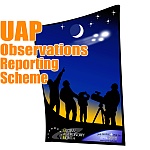Unidentified Aerospace Phenomena (UAP) Observations Reporting Scheme
THE PROJECT
Initiated during 2009 under the framework of the International Year of Astronomy, the Unidentified Aerospace Phenomena (UAP) Observations Reporting Scheme is aimed at facilitating the collection of UAP reports from both amateur and professional astronomers, via a questionnaire to be downloaded from a dedicated website.
Over the last 60 years the UAP subject (popularly known as UFOs) has generated intense interest and invaded the modern consciousness on a worldwide basis. Despite the fact that the majority of sightings can be attributed to the misidentification of natural or man-made objects, a small residue of cases seem to remain unexplained, and the debate over and fascination for the extraterrestrial hypothesis regularly resurfaces among the public.
The need for legitimacy of the UAP topic has been reiterated several times during the last two years when various countries, including France, the United Kingdom, Italy, and Denmark, have started officially opening their governmental files on the subject to the public and to the scientific community.
 |
OBJECTIVES OF THE PROJECT
Facilitate and enable the reporting of UAP sightings and collection of related instrumental records from the astronomical community, in the following ways:
1. Approach the UAP controversial field from a professional, rational, scientific standpoint and without any a priori assumptions.
- Stimulate, in the framework of the Global Astronomy Month (GAM), the submission of UAP reports that would have otherwise little chance to surface, encouraging witnesses to come forward with testimonies. We hope to greatly reduce individuals' reluctance to report a UAP sighting-reluctance based either on the assumption that no one will believe them, the fear of ridicule, or the assumption that nothing will be done with such reports.
- Contribute towards the collection of instrumental and photographic records of unidentified phenomenon. Many GAM 2010 observers will be equipped with technical equipment (telescopes, video-cameras, cameras with spectrographs), creating an excellent opportunity to obtain supplementary non-narrative data.
2. Help engage the public in discussions about the science behind what is seen in the sky, by:
- Allowing people to double-check their sightings against the most common nocturnal and daytime misidentifications and learn more about the various natural or man-made phenomena that can give rise to false UAP sightings.
- Enabling the public to become familiar with the difficulties in determining and reporting various parameters such as coordinates, altitude, distance, speed, and size-fundamental for an observational science such as astronomy.
3. Stimulate the general public, enthusing young (and not-so-young) people and prompting them to start looking upwards and outwards to make sense of their place in the Universe.
HOW TO SUBMIT A REPORT
For reporting a UAP observation, please fill out the website's forms, either manually (PDF file) or electronically (Word file). Two questionnaires are available for your use, in short and detailed versions, and in English and French. Your report has great value, as it will contribute to a better knowledge of transient phenomena occurring in the atmosphere. Please be as accurate and complete as possible-the more information we can gather on UAP characteristics the more comprehensive our analysis will be. Once you have completed your report form, please send it (including any applicable photos and audio/video clips) by email to: [email protected]
This information will be treated as confidential and will not be divulged to any third party. All the information collected from witnesses is for research purposes only.
MISIDENTIFICATIONS
It is certainly well known that the vast majority of UAP reports can be explained by a misidentification of some known natural or man-made phenomena and that well documented sightings defying a conventional explanation are rare (5% or less).
It is our hope that this website, aside from collecting serious reports from astronomers, could serve as a forum for educating the public about human, atmospheric, and astrophysical phenomena. Amateur astronomers and societies who receive questions about UFOs and flying saucers could potentially redirect the people to this website.
Possible misidentifications have been categorized as nocturnal (most frequent) and daytime, and under each item and whenever possible the following details have been listed: a general explanation of the item; specific telltale signs; and, finally, a "resource-help" providing links to relevant websites where people can further check details and develop their knowledge (e.g., satellite paths, star/planet charts, characteristics of meteors). Finally two flowcharts of common misidentifications are provided (also split into nocturnal and daytime) as a guide to help determine which item or event a sighting most closely resembles, following a series of descriptive clues.






